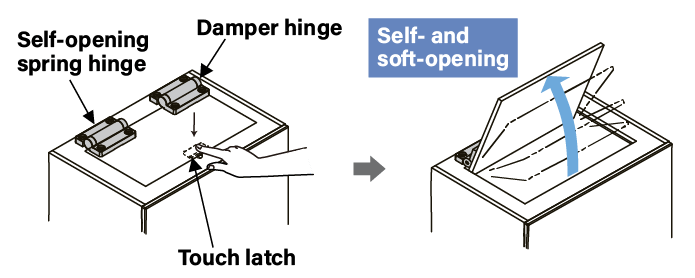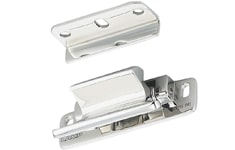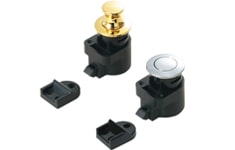A catch releases doors when pulled. There are various types of catches. Some use spring force to hold doors in a closed position, and others use magnet force.
- Company Top
- About our Products
- Hardware Basics
- Catches and Latches
Catches and Latches Hardware Basics
Catches and latches are used in a variety of places, such as furniture doors and equipment lids.
This section introduces the basics about them, what types there are, and ways to improve operability.
What is a catch? What is a latch?
Both catches and latches are used to keep doors closed, but they differ in a few important ways.
A latch holds doors closed, and will not release them without a specific releasing action. A latch can be released by pushing the door or pinching the latch.
Additionally, push-to-open latches allow doors to operate without the need of a handle. They apply force in the opening direction once the door is released.
About Holding Force
The holding force is the force that keeps doors closed. For example, when a magnetic catch with 3 kg of force is used, doors will not open unless more than 3 kg of force is applied.
Stronger holding force is required to hold larger doors. It is important to select holding force depending on the size of doors. Other advice for improving the operability of individual products will be described later.
How to Choose Different Types of Catches
What is a magnetic catch?

A magnetic catch holds a door closed using the force of a magnet. To use a magnetic catch, a counter plate must be paired with it. A magnetic catch is more compact than other catches because it does not require a holding mechanism.
Magnetic catches have three surface-mount types: a type that mounts flat to the surface, a type that mounts vertically to the surface and one that can be mounted either flat or vertically.

An ultra-thin magnetic catch with a thickness of under 3mm. Its compact width allows for it to be mounted on narrow furniture surfaces.
A back-mount bolt type that fixes in place with the use of nuts is also available.

How to choose a counter plate
A counter plate that is too small may not provide sufficient attraction force. Please choose a counter plate according to the information shown in the illustration.Although counter plates are not often used with sheet metal, make sure the counter plate is the same size as the yoke or larger.
What is a tension catch?
The tension catch is a latch mechanism comprising of a catch plate and two spring-loaded balls that are fixed onto the door and frame respectively. When the door is closed, the spring-loaded balls exert force against the protrusion on the catch plate, effectively holding the door firmly in position.The catch can retain the counter plate from the front or sides.
What is a resin catch?
Resin catches are specifically designed to keep doors securely shut by utilizing the body of the catch to engage the catch plate. They are ideal for use in damp environments as they are not susceptible to rust. There are two variations of resin catches, one held in place by a roller and the other with a clip. Compared to other types of catches, resin catches are more economical.
How to Choose Different Types of Latches
What is a touch latch?
Touch latches use a spring-loaded latch mechanism to hold a cabinet or drawer in place when pushed closed. As shown in the video clip, they can be opened closed by applying pressure to the surface of the door or drawer.
Doors can be opened and closed with a push, eliminating the need for a handle or knob.
Some types of latches are released by pressing the knob on the latch rather than the door.

A standard touch latch.
Small misalignments can be accommodated due to the slight movability of the counter plate.The latch has passed a private open/close cycle test and is highly durable.
What is a magnetic latch?
A magnetic latch is a type of latch that utilizes magnetic force to keep a door or cabinet closed. It consists of a magnet and a magnetic strike plate, which attract each other and hold the door or cabinet in place.
A door that can be opened and closed with a simple push enables it to be used without the need for handles or knobs.
How to improve the operability of thick and heavy doors
-
Choose a magnetic latch with a strong pushing force.
"Pushing force" refers to the force required for the latch to disengage. For heavy doors, choosing a latch that can firmly push out the door can improve its operability.
Example: Metal Magnetic Latch, ML-ZN80 (product used in the moving image) -
Choose a magnetic latch with a long stroke.
The "stroke" is the length of a latch that pops out. For a thick door, choose a latch that pops firmly forward to make the door easier to operate.
Example: Large Magnetic Latch, ML-120
What is a safety latch?
A safety latch is a latch that requires a specific action to open a door, such as pinching a lever or pushing a button.
Although these latches are not designed to latch doors when they detect shaking like earthquake-resistant latches, they are popular as a countermeasure against earthquake and other shaking because doors are always latched, which prevents stored items from falling out unexpectedly.
What is a panel latch?
A panel latch holds panel covers closed. A key or lever is used to release the latch and allow for removal of the panel as shown in the moving image.
Recommended for maintenance panels, where access is restricted to maintenance workers that have the key to open and close the panel.
What is a latch handle?
A latch handle is a type of door handle that is used to operate a latch mechanism on a door. It typically has a lever or knob that is turned or pushed to engage or disengage the latch.














